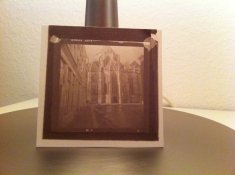Juergen
Member

So I finally got started with salt printing over the weekend. My very first print is a small contact print from a 6x6 Tri-X negative. I am pleased that I got anything at all, but I do feel there's a lot to improve. The print was exposed to a UV face tanner lamp for 12 minutes placed 75 cm away from the lamp. The negative I used was 'stand' developed in Rodinal for a full hour.
In order to get better results, I feel I need a much denser negative as a 'normal' density negative, is clearly not enough. If anyone can share some tips on how to achieve this, I'd be grateful. I'm currently using Rodinal and Tri-X as my standard dev/film combo.
p.s. I really enjoyed the process, it's a lot of fun!


